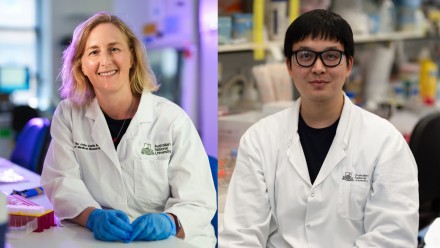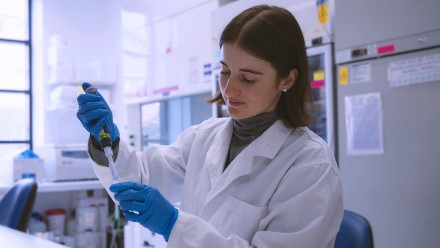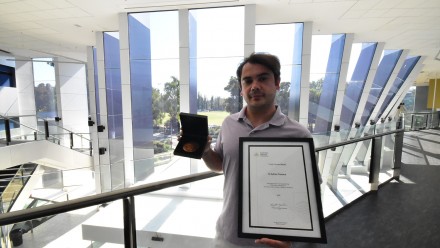Dr Jason Potas

Contacts
Jason commenced his scientific career at The University of Sydney, examining how different sensory (somatic and visceral) information affects blood pressure, by studying the spinal and brainstem functional and anatomical connections to autonomic control centres. He also examined haemodynamic and anaphylactic shock responses and the associated central mechanisms affecting these responses. During his first post-doc at the Humboldt University, Berlin, Jason studied the cellular responses to cerebral ischaemia. He later returned to Australia, where he investigated the cellular responses and the role of the immune system on reducing functional outcomes after spinal cord injury at the University of New South Wales. He later joined the Federal University of Rio de Janeiro, Brazil, where he examined the electrophysiological properties of regenerating nervous tissues in response to peripheral nerve and spinal cord injury, and investigated the efficacy of cellular therapies on regeneration. Jason also devised new injury models and evaluation techniques, including computational techniques for automated evaluation of neural function. Jason returned to Australia after working for three years in industry in Brazil, to join the ANU Medical School as a lecturer, and to establish the Neural Control Systems Laboratory at the John Curtin School of Medical Research.
Research interests
The central nervous system is a command centre that controls various aspects of our everyday lives using autonomic and conscious control systems. My main interests are in the understanding of how sensory and motor information is coded, relayed and processed by the nervous system, and how this information is utilised and integrated. Also of interest are how these systems are affected by injury and disease, how they adapt or are modified, and the mechanisms involved under such conditions.
Investigations from our laboratory range from therapeutic-focused research projects to basic science questions. We use a combination of electrophysiology, behavioural analysis and immunohistochemistry to evaluate different aspects of structure and function of sensory and motor systems under normal and injury conditions.
The use of photobiomodulation and novel biomaterials to promote nervous tissue recovery of peripheral nerves and the spinal cord are examples of therapeutic-focused projects. Photobiomodulation refers to the alteration of cellular biology in response to the absorption of light energy. Our team have demonstrated that the use of red (670 nm) light following injury to central or peripheral nervous tissues can improve behavioural and electrophysiological outcomes, alter the balance of inflammatory cell populations, reduce cell death and increase axonal sprouting. We have also found that red light treatment reduces signs of neuropathic pain in both our animal models of spinal cord and peripheral nerve injury. Neuropathic pain is currently poorly treated, and our studies may contribute toward new strategies with greater treatment success.
We have also used novel biomaterials to alter the cellular microenvironment around peripheral nerves. These biomaterials can be engineered to retain and release biological factors into the surrounding tissues at the site of implantation at controlled levels and intervals. We have recently conjugated interleukin-10 and interferon-g to nanofibre scaffolds and demonstrated its biological activity in vivo on altering macrophage populations in and around the peripheral nerve. Manipulating the microenvironment to harness the body’s inherent biology may also prove to be a novel strategy toward promoting regeneration following neural injury.
Our other main interest is the interface between biology and machine. We are currently recording from a brainstem region, called the dorsal column nuclei, where sensory information from the entire body is “summarised” before it is sent to higher brain regions for sensory processing. By stimulating the body and recording multiple signals simultaneously from the dorsal column nuclei, we aim to extract information from these electrical signals that can informs us of the location and quality of a sensory event experienced on the body. The ability to decode these signals is the first step in the design of “bionic touch”, a futuristic sensory prosthetic device that could restore sensation to spinal cord or peripheral nerve injured patients. We have recently extracted key features from an array of electrical signatures recorded across the surface of the dorsal column nuclei, and used these in a machine learning approach to predict the origin of sensory input in the periphery. Our next goal is to predict the quality of sensory input. By appropriately stimulating the dorsal column nuclei, we could one day be able to trick the brain into perceiving sensation on the body. While bionic touch is currently futuristic, our pursuit of this aim is generating interesting data that improves our understanding of sensory information processing.
Groups
- Potas, J, Gonvales de Castro, N, Maddess, T et al 2015, 'Waveform Similarity Analysis: A Simple Template Comparing Approach for Detecting and Quantifying Noisy Evoked Compound Action Potentials', PLOS ONE (Public Library of Science), vol. 10, no. 9, pp. 1-18.
- Potas, J, Haque, F, Maclean, F et al 2015, 'Interleukin-10 conjugated electrospun polycaprolactone (PCL) nanofibre scaffolds for promoting alternatively activated (M2) macrophages around the peripheral nerve in vivo', Journal of Immunological Methods, vol. online, pp. 1-12.
- Fernandez-Klett, F, Potas, J, Hilpert, D et al 2013, 'Early loss of pericytes and perivascular stromal cell-induced scar formation after stroke', Journal of Cerebral Blood Flow and Metabolism, vol. 33, no. 3, pp. 428-439.
- Potas, J, Zheng, Y, Moussa, C et al 2006, 'Augmented Locomotor Recovery after Spinal Cord Injury in the Athymic Nude Rat', Journal of Neurotrauma, vol. 23, no. 5, pp. 660-673.
- Potas, J, Dirnagl, U & Priller, J 2005, 'Molecular and cellular changes in stroke: an emphasis on glial and inflammatory mechanisms', in Sean P Brown (ed.), Focus on Stroke Research, Nova Biomedical Books, New York, pp. 27-50.
- Potas, JR; Briscoe, H; Horiuchi, J; et al 2004, 'Renal sympathetic and cardiac changes associated with anaphylactic hypotension', Autonomic Neuroscience-Basic & Clinical Volume: 112 Issue: 1-2 Pages: 25-30
- Potas, JR; Dampney, RAL. 2004, 'Evidence that venoconstriction reverses the phase II sympathoinhibitory and bradycardic response to haemorrhage', Autonomic Neuroscience-Basic & Clinical Volume: 111 Issue: 1 Pages: 1-6
- Potas, JR; Dampney, RAL. 'Sympathoinhibitory pathway from caudal midline medulla to RVLM is independent of baroreceptor reflex pathway', American Journal of Physiology-Regulatory Integrative and Comparative Physiology Volume: 284 Issue: 4 Pages: R1071-R1078
- Potas, JR; Keay, KA; Henderson, LA; et al.'Somatic and visceral afferents to the 'vasodepressor region' of the caudal midline medulla in the rat', European Journal of Neuroscience Volume: 17 Issue: 6 Pages: 1135-1149











